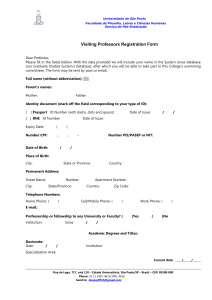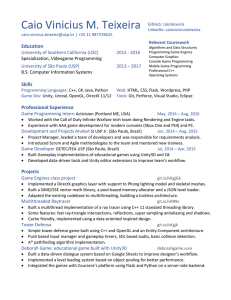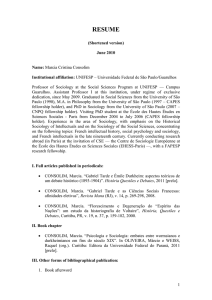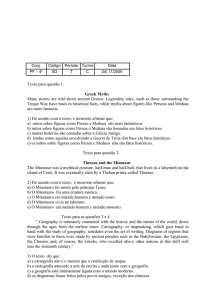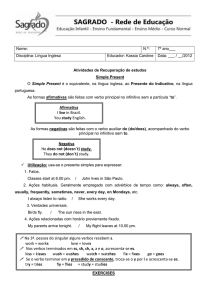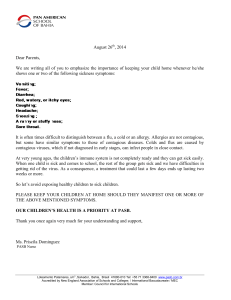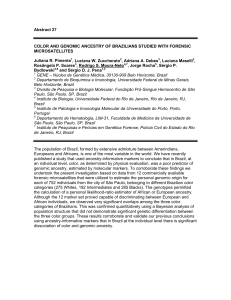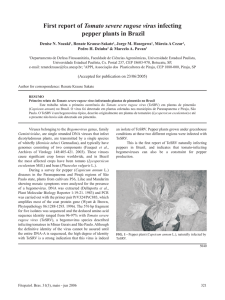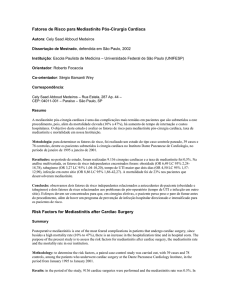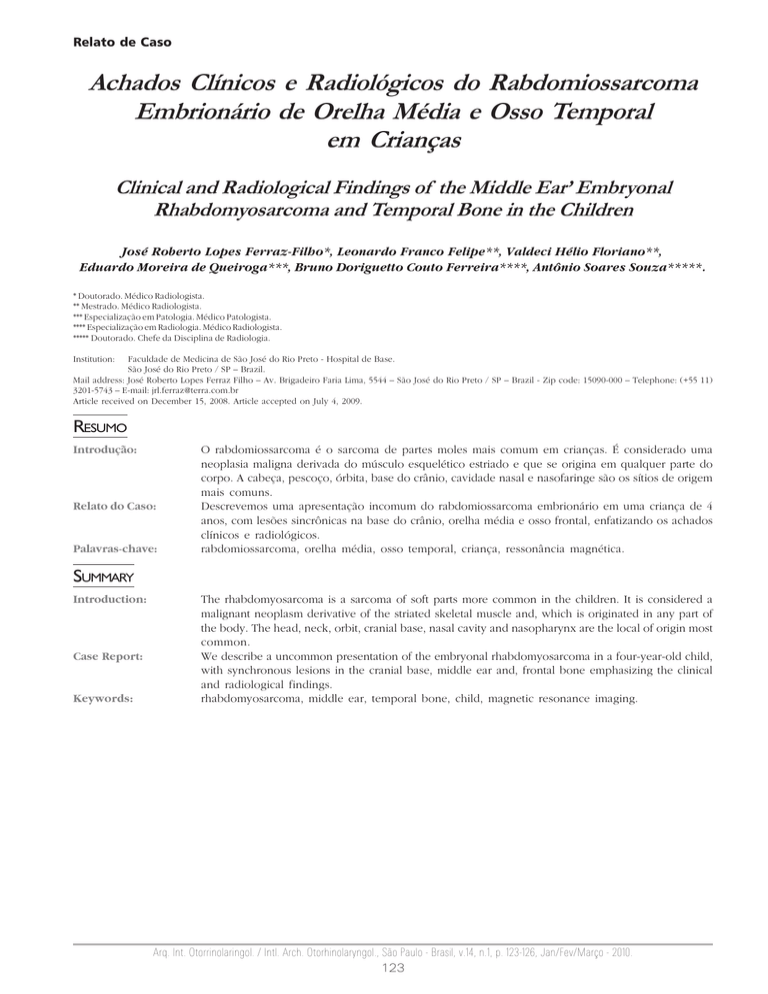
Relato de Caso
Achados Clínicos e Radiológicos do Rabdomiossarcoma
Embrionário de Orelha Média e Osso Temporal
em Crianças
Clinical and Radiological Findings of the Middle Ear’ Embryonal
Rhabdomyosarcoma and Temporal Bone in the Children
José Roberto Lopes Ferraz-Filho*, Leonardo Franco Felipe**, Valdeci Hélio Floriano**,
Eduardo Moreira de Queiroga***, Bruno Doriguetto Couto Ferreira****, Antônio Soares Souza*****.
* Doutorado. Médico Radiologista.
** Mestrado. Médico Radiologista.
*** Especialização em Patologia. Médico Patologista.
**** Especialização em Radiologia. Médico Radiologista.
***** Doutorado. Chefe da Disciplina de Radiologia.
Institution:
Faculdade de Medicina de São José do Rio Preto - Hospital de Base.
São José do Rio Preto / SP – Brazil.
Mail address: José Roberto Lopes Ferraz Filho – Av. Brigadeiro Faria Lima, 5544 – São José do Rio Preto / SP – Brazil - Zip code: 15090-000 – Telephone: (+55 11)
3201-5743 – E-mail: [email protected]
Article received on December 15, 2008. Article accepted on July 4, 2009.
RESUMO
Introdução:
Relato do Caso:
Palavras-chave:
O rabdomiossarcoma é o sarcoma de partes moles mais comum em crianças. É considerado uma
neoplasia maligna derivada do músculo esquelético estriado e que se origina em qualquer parte do
corpo. A cabeça, pescoço, órbita, base do crânio, cavidade nasal e nasofaringe são os sítios de origem
mais comuns.
Descrevemos uma apresentação incomum do rabdomiossarcoma embrionário em uma criança de 4
anos, com lesões sincrônicas na base do crânio, orelha média e osso frontal, enfatizando os achados
clínicos e radiológicos.
rabdomiossarcoma, orelha média, osso temporal, criança, ressonância magnética.
SUMMARY
Introduction:
Case Report:
Keywords:
The rhabdomyosarcoma is a sarcoma of soft parts more common in the children. It is considered a
malignant neoplasm derivative of the striated skeletal muscle and, which is originated in any part of
the body. The head, neck, orbit, cranial base, nasal cavity and nasopharynx are the local of origin most
common.
We describe a uncommon presentation of the embryonal rhabdomyosarcoma in a four-year-old child,
with synchronous lesions in the cranial base, middle ear and, frontal bone emphasizing the clinical
and radiological findings.
rhabdomyosarcoma, middle ear, temporal bone, child, magnetic resonance imaging.
Arq. Int. Otorrinolaringol. / Intl. Arch. Otorhinolaryngol., São Paulo - Brasil, v.14, n.1, p. 123-126, Jan/Fev/Março - 2010.
123
Achados clínicos e radiológicos do rabdomiossarcoma embrionário de orelha média e osso temporal em crianças.
Ferraz-Filho et al.
INTRODUCTION
The rhabdomyosarcoma is an aggressive tumour
accounting for 5-8% of all pediatric malignancies and for
over 50% of all soft tissue sarcomas in children (1-5). It is
considered a malignant neoplasia derived from striated
muscle arising in any part of the body, however, it is more
common in regions of the head and neck, genitourinary
tract, retroperitoneum and extremities (3-5). Approximately
30% of all pediatric rhabdomyosarcomas occur in the head
and neck and common sites of origin are the orbits, base of
the skull, nasal cavity and nasopharynx. In nasopharynx,
usually, it involves the middle ear, paranasal sinus and
masticatory space (5).
Rhabdomyosarcomas are classified based on
histopathologic features, which have distinct clinical
characteristics: embryonal (the most common type in
infants and young children), alveolar, botryoid, spindle cell
and anaplastic variants (6).
The purpose of this study is to report a case of
middle ear and temporal bone embryonal
rhabdomyosarcoma associated with exudative otitis media
emphasizing both clinical and radiological findings.
Picture 1. CT showed destruction of the petrous part of
temporal bone, carotid canal on the right (A,B) and right
frontal bone (C,D).
CASE REPORT
A boy, aged 4 years, presenting otalgia and irritability
for the last 30 days where was diagnosed an otitis media.
After a short course of antibiotics and analgesics the child
developed deviation of the eye to the right, facial paralysis,
and hearing impairment on the right.
The neurologic examination findings included facial
and abducens nerve palsy on the right. The otoscopic
examination showed a fragile and reddish tissue in the
external acoustic meatus. The tympanic membrane was
intact presenting hyperemia and bulging. Pure-tone
audiometry detected a 45-dB hearing loss in this ear. There
was no detectable lymphadenopathy on palpation.
A computed tomography (CT) of the head showed
destruction of the petrous part of temporal bone and right
carotid canal associated another lesion with soft-tissue
component in the right frontal bone (Picture 1). The
magnetic resonance imaging (MRI) showed lesions
hypointese in T1-weighted sequences and hyperintense
in T2-weighted sequences (Picture 2) with contrast
enhancement (Picture 3) located in the petrous part of
right temporal bone, middle ear and clivus. In association,
it was observed a lesion in the right frontal bone along with
the coronal suture.
Picture 2. MRI T2 weighted images showed synchronic
hyperintense lesions with soft-tissue component located in
the petrous part of right temporal bone extending to the
sphenoid and clivus (A,B,C) and associated with lesion of
right frontal bone (D).
Arq. Int. Otorrinolaringol. / Intl. Arch. Otorhinolaryngol., São Paulo - Brasil, v.14, n.1, p. 123-126, Jan/Fev/Março - 2010.
124
Achados clínicos e radiológicos do rabdomiossarcoma embrionário de orelha média e osso temporal em crianças.
Ferraz-Filho et al.
Rhabdomyosarcomas may have their origin in any
anatomical localization occurring predominantly in head
and neck regions, orbits, skull base, nasal cavity, and
nasopharynx where there is little or no musculoskeletal
tissue (1,9). In pediatric cases, about 30 to 40% occur in the
head and neck regions (10), however, the ear and the
temporal bone are uncommon sites of involvement (7,8,11).
Middle ear rhabdomyosarcomas were reported in
the literature with a range of symptoms that clinically
simulates chronic otitis media. The most commons are
facial nerve palsy, headache, hearing impairment, and
bleeding (5). However, the findings of facial palsy with
involvement of nerve roots and lesions of the perineural
and parameningeal spaces are more suggestive of
malignancy. Enlarged lymphonodes are more likely
associated with distant metastasis (5,7).
Picture 3. MRI T1 weighted images showed hypointese lesion
located in the petrous part of right temporal bone (A), with
contrast enhancement (B,C) and associated with lesion of
right frontal bone (D).
The impairment of the right abducens nerve has
occurred by involvement of Dorello canal and the facial
and vestibulocochlear nerve by involvement of the internal
acoustic meatus and the ipsilateral tympanic cavity.
Biopsy of the right external acoustic meatus showed
chronic otitis externa with granulation tissue and rare
atypical cells. The immunohistochemical methods
confirmed, through the antibody expressions for desmin
and myogenin, the diagnosis of embryonal
rhabdomyosarcoma.
The tumor was resected by radical mastoidectomy
via postauricular with meatoplasty and the child was
started on multiagent chemotherapy and radiotherapy.
This study was approved by the Ethics Research
Committee of the Institution.
Metastasis can be present in up to 30% of the cases.
The most common affected sites are the lungs, liver, bones
and extremities (5,12). In our case, the early diagnosis was
otitis media followed of the paralysis of the cranial nerves
by involvement of the space perineural and presence of
distant frontal bone lesion.
The MRI study is the exam of choice because it
more precisely defines the extent of tumor, as well as its
signal pattern, boundaries, and post-contrast enhancement
(13,14). In the case reported the lesion presented
predominantly hyperintense in T2-weighted sequences,
hypointense in T1-weighted sequences with homogeneous
contrast enhancement and impairment of the perineural
space.
Rhabdomyosarcomas affecting the perineural and
parameningeal spaces, nasopharynx, paranasal sinuses,
and temporal bone, generally are not amenable to surgical
resection. In these areas, there is increased risk of serious
damage to cranial nerves and deformation of the facial
skeleton by radical surgery, and it is unlikely to complete
resection. The treatment of choice for these tumors is
chemotherapy and radiotherapy, with surgery limited to
diagnostic biopsy (7,11).
DISCUSSION
Plexiform neurofibromas, juvenile angiofibroma, nonHodgkin lymphoma, nasopharyngeal carcinoma,
histiocytosis and cholesteatoma must be included among
the differential diagnosis (15).
Embryonal is the most common histologic subtype
of rhabdomyosarcomas. It is responsible for 70 to 80% of
the presentations and its origin is supposed to be triggered
by a disorder in mesenchymal primitive differentiation of
the musculoskeletal cells in their first or earliest stages of
embryogenesis (3,7,8).
The diagnosis of middle ear and the temporal bone
rhabdomyosarcoma is difficulted when associated
inflammatory-infectious diseases, such as exudative otitis
media that may mask the base disease and delay the
definite diagnosis. In these cases, early correlation with
imaging screenings is essential.
Arq. Int. Otorrinolaringol. / Intl. Arch. Otorhinolaryngol., São Paulo - Brasil, v.14, n.1, p. 123-126, Jan/Fev/Março - 2010.
125
Achados clínicos e radiológicos do rabdomiossarcoma embrionário de orelha média e osso temporal em crianças.
Ferraz-Filho et al.
BIBLIOGRAPHICAL REFERENCES
9. Viswanatha B. Embryonal rhabdomyosarcoma of the
temporal bone. Ear Nose Throat J. 2007, 86(4):218-222.
1. Arita K, Sugiyama K, Tominaga A, Yamasaki F. Intrasellar
rhabdomyosarcoma: case report. Neurosurgery. 2001,
48(3):677-680.
10. Goto TK, Yoshiura K, Tanaka T, Kanda S, Ozeki S,
Ohishi M, et al. A follow-up of rhabdomyosarcoma of
the infratemporal fossa region in adults based on the
magnetic resonance imaging findings: case reports. Oral
Surg Oral Med Oral Pathol Oral Radiol Endod. 1998,
86(5):616-625.
2. Kim EE, Valenzuela RF, Kumar AJ, Raney RB, Eftekari F.
Imaging and clinical spectrum of rhabdomyosarcoma in
children. Clin Imaging 2000, 24(5):257-262.
3. Ho RH, Johnson J, Dev VG, Whitlock JA. A novel
t(2;20)(q35;p12) in embryonal rhabdomyosarcoma. Cancer
Genet Cytogenet. 2004, 151(1):73-77.
4. Cil T, Altintas A, Isikdogan A. Rhabdomyosarcoma
presenting with destructive large lesion of the face. South
Med J. 2008, 101:104-105.
5. Durve DV, Kanegaonkar RG, Albert D, Levitt G. Pediatric
rhabdomyosarcoma of the ear and temporal bone. Clin
Otolaryngol Allied Sci. 2004, 29(1):32-37.
6. Parham DM, Ellison DA. Rhabdomyosarcomas in adults
and children: an update. Arch Pathol Lab Med. 2006,
130(10):1454-1465.
11. Daya H, Chan HS, Sirkin W, Forte V. Pediatric
rhabdomyosarcoma of the head and neck: is there a place
for surgical management? Arch Otolaryngol Head Neck Surg.
2000, 126(4):468-472.
12. Binokay F, Soyupak SK, Inal M, Celiktas M, Akgul E,
Aksungur E. Primary and metastatic rhabdomyosarcoma in
the breast: report of two pediatric cases. Eur J Radiol. 2003,
48(3):282-284.
13. Yang WT, Kwan WH, Li CK, Metreweli C. Imaging of
pediatric head and neck rhabdomyosarcomas with
emphasis on magnetic resonance imaging and a review of
the literature. Pediatr Hematol Oncol. 1997, 14(3):243257.
7. Sbeity S, Abella A, Arcand P, Quintal MC, Saliba I. Temporal
bone rhabdomyosarcoma in children. Int J Pediatr
Otorhinolaryngol. 2007, 71(5):807-814.
14. Lee JH, Lee MS, Lee BH, Choe DH, Do YS, Kim KH,
et al. Rhabdomyosarcoma of the head and neck in adults:
MR and CT findings. Am J Neuroradiol. 1996, 17:19231928.
8. Andrassy RJ. Rhabdomyosarcoma. Semin Pediatr Surg.
1997, 6:17-23.
15. Dickson PV, Davidoff AM. Malignant neoplasms of the
head and neck. Semin Pediatr Surg. 2006, 15:92-98.
Arq. Int. Otorrinolaringol. / Intl. Arch. Otorhinolaryngol., São Paulo - Brasil, v.14, n.1, p. 123-126, Jan/Fev/Março - 2010.
126

